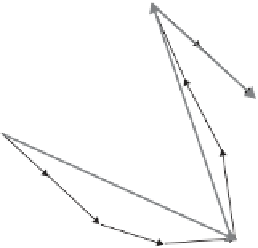Database Reference
In-Depth Information
d
j
β
i+1
α
t+1
s
t
(
x
t
,
y
t
,)
(b)
Figure 13.2 Computation of turning angles and move lengths in a trajectory. (a) A path
sampled at fixed time intervals denoted by index
t
. Black dots represent spatio-temporal
positions (
t
=
1
,
2
,...,T
). Red arrows joining consecutive spatio-temporal positions are
the steps of discretization of module
s
t
and angle
α
t
,(
s
t
is defined in [1
,T
−
1] and
α
in [2
,T
]). (b) Sampling at unequal time intervals denoted by index
i
. Each grey arrow
represents a move of length
d
i
. Note that
α
indicates turning angles between steps, while
β
represents turning angles between moves.
(a)
Figure
13.3
a one can observe that fallow deer do not use pastures at random.
Some locations are much more exploited than others. Even within the same
habitat, animal movements appear quite variable. In Figure
13.3
b we present
some examples of paths of fallow deer recorded at twilight in an large open
habitat surrounded by a dense forest where deer remain during the daytime in
order to minimize disturbance and risk for neonates; at night they move to open
fields to forage on good-quality food available in meadows, especially during
spring. Spatio-temporal positions were collected by observers hidden in high
seats scattered in the study areas to understand short-scale habitat selection and
dynamics of social organization.
The aim of the study was to identify general mechanisms able to reproduce
animal movements. The basic model proposed by Okubo (1980) is the Brownian
diffusion. In this specific model, the distribution of turning angles,
α
t
, is uniform,
that is, there is not directional persistence, while the distribution of distances
d
t
can assume different forms provided the originating distribution is characterized
by a finite variance. Let us suppose we are studying the movement of a “jumping
frog” in a one-dimensional universe (Figure
13.4
). The rules of movement for a
solitary frog are:
1. The frog jumps from the starting coordinate
d
0
=
0 (at time
t
=
0). It may
move leftward or rightward with probability 0.5.
2. Each jump, or move, is of constant length
δ
for a constant time duration
τ
.
3. Each move is independent from any previous move.







